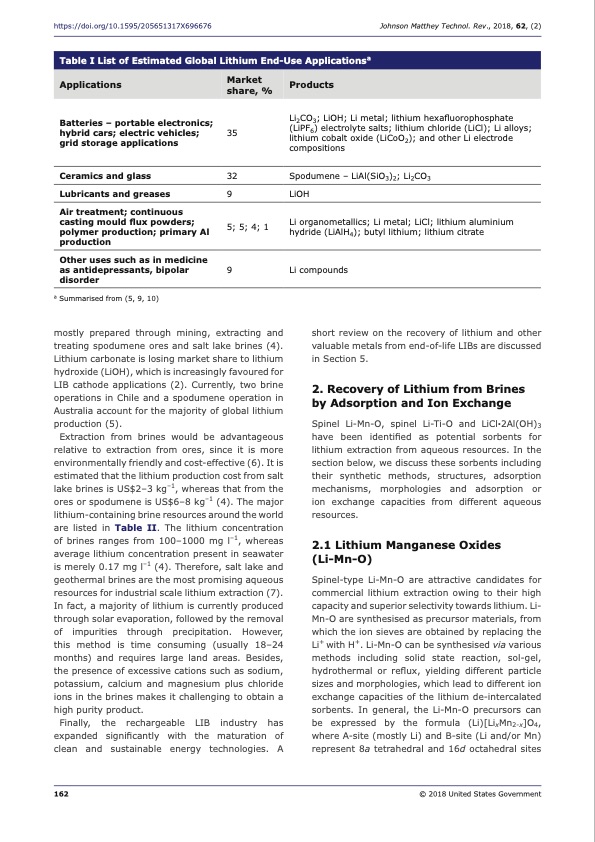
PDF Publication Title:
Text from PDF Page: 002
https://doi.org/10.1595/205651317X696676 Johnson Matthey Technol. Rev., 2018, 62, (2) Table I List of Estimated Global Lithium End-Use Applicationsa Applications Market Products share, % Batteries – portable electronics; hybrid cars; electric vehicles; grid storage applications Ceramics and glass Lubricants and greases Air treatment; continuous casting mould flux powders; polymer production; primary Al production Other uses such as in medicine as antidepressants, bipolar disorder a Summarised from (5, 9, 10) 35 32 9 5; 5; 4; 1 9 Li2CO3; LiOH; Li metal; lithium hexafluorophosphate (LiPF6) electrolyte salts; lithium chloride (LiCl); Li alloys; lithium cobalt oxide (LiCoO2); and other Li electrode compositions Spodumene – LiAl(SiO3)2; Li2CO3 LiOH Li organometallics; Li metal; LiCl; lithium aluminium hydride (LiAlH4); butyl lithium; lithium citrate Li compounds short review on the recovery of lithium and other valuable metals from end-of-life LIBs are discussed in Section 5. 2. Recovery of Lithium from Brines by Adsorption and Ion Exchange Spinel Li-Mn-O, spinel Li-Ti-O and LiCl·2Al(OH)3 have been identified as potential sorbents for lithium extraction from aqueous resources. In the section below, we discuss these sorbents including their synthetic methods, structures, adsorption mechanisms, morphologies and adsorption or ion exchange capacities from different aqueous resources. 2.1 Lithium Manganese Oxides (Li-Mn-O) Spinel-type Li-Mn-O are attractive candidates for commercial lithium extraction owing to their high capacity and superior selectivity towards lithium. Li Mn-O are synthesised as precursor materials, from which the ion sieves are obtained by replacing the Li+ with H+. Li-Mn-O can be synthesised via various methods including solid state reaction, sol-gel, hydrothermal or reflux, yielding different particle sizes and morphologies, which lead to different ion exchange capacities of the lithium de-intercalated sorbents. In general, the Li-Mn-O precursors can be expressed by the formula (Li)[LixMn2-x]O4, where A-site (mostly Li) and B-site (Li and/or Mn) represent 8a tetrahedral and 16d octahedral sites mostly prepared through mining, extracting and treating spodumene ores and salt lake brines (4). Lithium carbonate is losing market share to lithium hydroxide (LiOH), which is increasingly favoured for LIB cathode applications (2). Currently, two brine operations in Chile and a spodumene operation in Australia account for the majority of global lithium production (5). Extraction from brines would be advantageous relative to extraction from ores, since it is more environmentally friendly and cost-effective (6). It is estimated that the lithium production cost from salt lake brines is US$2–3 kg–1, whereas that from the ores or spodumene is US$6–8 kg–1 (4). The major lithium-containing brine resources around the world are listed in Table II. The lithium concentration of brines ranges from 100–1000 mg l–1, whereas average lithium concentration present in seawater is merely 0.17 mg l–1 (4). Therefore, salt lake and geothermal brines are the most promising aqueous resources for industrial scale lithium extraction (7). In fact, a majority of lithium is currently produced through solar evaporation, followed by the removal of impurities through precipitation. However, this method is time consuming (usually 18–24 months) and requires large land areas. Besides, the presence of excessive cations such as sodium, potassium, calcium and magnesium plus chloride ions in the brines makes it challenging to obtain a high purity product. Finally, the rechargeable LIB industry has expanded significantly with the maturation of clean and sustainable energy technologies. A 162 © 2018 United States GovernmentPDF Image | Lithium Recovery from Aqueous Resources

PDF Search Title:
Lithium Recovery from Aqueous ResourcesOriginal File Name Searched:
b8befda967a8ccf19190203d3b5aeae0673f.pdfDIY PDF Search: Google It | Yahoo | Bing
Product and Development Focus for Infinity Turbine
ORC Waste Heat Turbine and ORC System Build Plans: All turbine plans are $10,000 each. This allows you to build a system and then consider licensing for production after you have completed and tested a unit.Redox Flow Battery Technology: With the advent of the new USA tax credits for producing and selling batteries ($35/kW) we are focussing on a simple flow battery using shipping containers as the modular electrolyte storage units with tax credits up to $140,000 per system. Our main focus is on the salt battery. This battery can be used for both thermal and electrical storage applications. We call it the Cogeneration Battery or Cogen Battery. One project is converting salt (brine) based water conditioners to simultaneously produce power. In addition, there are many opportunities to extract Lithium from brine (salt lakes, groundwater, and producer water).Salt water or brine are huge sources for lithium. Most of the worlds lithium is acquired from a brine source. It's even in seawater in a low concentration. Brine is also a byproduct of huge powerplants, which can now use that as an electrolyte and a huge flow battery (which allows storage at the source).We welcome any business and equipment inquiries, as well as licensing our turbines for manufacturing.| CONTACT TEL: 608-238-6001 Email: greg@infinityturbine.com | RSS | AMP |